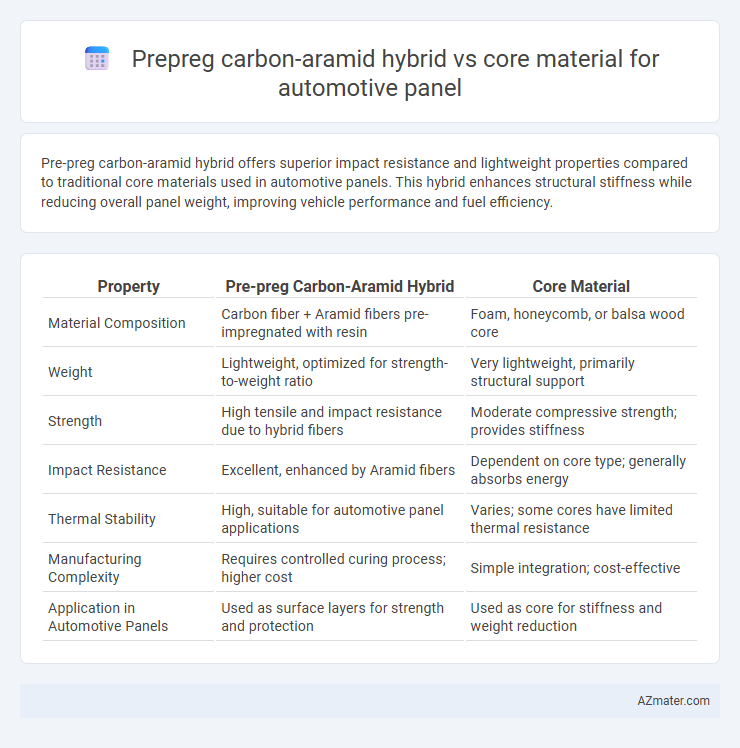Pre-preg carbon-aramid hybrid offers superior impact resistance and lightweight properties compared to traditional core materials used in automotive panels. This hybrid enhances structural stiffness while reducing overall panel weight, improving vehicle performance and fuel efficiency.
Table of Comparison
| Property | Pre-preg Carbon-Aramid Hybrid | Core Material |
|---|---|---|
| Material Composition | Carbon fiber + Aramid fibers pre-impregnated with resin | Foam, honeycomb, or balsa wood core |
| Weight | Lightweight, optimized for strength-to-weight ratio | Very lightweight, primarily structural support |
| Strength | High tensile and impact resistance due to hybrid fibers | Moderate compressive strength; provides stiffness |
| Impact Resistance | Excellent, enhanced by Aramid fibers | Dependent on core type; generally absorbs energy |
| Thermal Stability | High, suitable for automotive panel applications | Varies; some cores have limited thermal resistance |
| Manufacturing Complexity | Requires controlled curing process; higher cost | Simple integration; cost-effective |
| Application in Automotive Panels | Used as surface layers for strength and protection | Used as core for stiffness and weight reduction |
Introduction to Automotive Panel Materials
Pre-preg carbon-aramid hybrids offer a superior strength-to-weight ratio and enhanced impact resistance compared to traditional core materials used in automotive panels. These hybrids integrate carbon fiber's stiffness with aramid's toughness, making them ideal for lightweight, durable automotive body components. Core materials like foam or honeycomb structures primarily provide thickness and rigidity but lack the combined mechanical performance of pre-preg carbon-aramid composites.
Overview of Pre-preg Carbon-Aramid Hybrids
Pre-preg carbon-aramid hybrids combine high tensile strength carbon fibers with impact-resistant aramid fibers, offering an optimal balance of stiffness, toughness, and energy absorption suitable for automotive panels. Their layered architecture enhances crashworthiness while maintaining lightweight characteristics crucial for vehicle efficiency and performance. These hybrid composites outperform traditional core materials by providing superior structural integrity and weight reduction potential in automotive applications.
Core Materials: Types and Applications
Core materials in automotive panels, such as foam, honeycomb structures, and balsa wood, provide essential lightweight strength and energy absorption properties for enhanced crashworthiness and fuel efficiency. Foam cores made from PET or PVC offer excellent thermal insulation and impact resistance, whereas honeycomb cores, typically aluminum or Nomex, deliver superior stiffness and load distribution while maintaining minimal weight. Balsa wood cores balance sustainability and mechanical performance, making them a preferred choice in hybrid composite panels combining pre-preg carbon-aramid fibers for high strength-to-weight ratios and durability.
Mechanical Properties Comparison
Pre-preg carbon-aramid hybrid composites exhibit enhanced impact resistance and tensile strength compared to traditional core materials used in automotive panels, such as polyurethane foam or balsa wood. The hybrid material offers superior stiffness-to-weight ratio and improved energy absorption, making it ideal for crashworthiness and durability in automotive applications. Mechanical testing reveals that carbon-aramid hybrids provide better fatigue resistance and higher shear strength, contributing to longer panel lifespan and overall vehicle safety performance.
Weight and Performance Analysis
Pre-preg carbon-aramid hybrid composites exhibit superior strength-to-weight ratios compared to traditional core materials used in automotive panels, significantly reducing overall vehicle weight while maintaining high impact resistance. The hybrid's enhanced mechanical properties offer improved energy absorption and durability, leading to better crash performance and longevity under dynamic loads. Weight savings achieved with carbon-aramid hybrids contribute to increased fuel efficiency and reduced emissions, making them a preferred choice in lightweight automotive design over conventional core materials such as foam or honeycomb.
Cost Implications for Manufacturing
Pre-preg carbon-aramid hybrid composites offer a balance of high strength-to-weight ratio and improved impact resistance but come with higher raw material costs and specialized processing requirements that increase manufacturing expenses. In contrast, traditional core materials like foam or honeycomb structures are generally more cost-effective due to lower material expenses and simpler fabrication processes, though they may lack the advanced mechanical performance of hybrid pre-pregs. Manufacturers must weigh the trade-offs between upfront material and production costs versus long-term benefits such as weight reduction and enhanced durability when selecting materials for automotive panels.
Durability and Impact Resistance
Pre-preg carbon-aramid hybrid materials exhibit superior durability and impact resistance compared to traditional core materials in automotive panels due to the synergistic combination of carbon fiber's stiffness and aramid fiber's energy absorption capabilities. This hybrid construction enhances resistance to crack propagation and improves overall panel longevity under dynamic loading conditions. The use of pre-preg carbon-aramid hybrids results in lightweight automotive panels with enhanced toughness, making them highly suitable for crash-prone areas in vehicle structures.
Design Flexibility and Applications
Pre-preg carbon-aramid hybrid composites offer superior design flexibility for automotive panels due to their enhanced impact resistance and tailored stiffness, enabling intricate shapes and lightweight structures crucial for performance vehicles. Core materials, such as foam or honeycomb, primarily provide structural support and thickness without significantly contributing to tensile strength, limiting complex geometries but enhancing sandwich panel rigidity and energy absorption. Applications of pre-preg carbon-aramid hybrids excel in high-performance body panels requiring damage tolerance and weight reduction, whereas core materials are favored in large-area panels demanding stiffness and crashworthiness with cost-effectiveness.
Sustainability and Environmental Considerations
Pre-preg carbon-aramid hybrid composites offer enhanced sustainability for automotive panels by combining lightweight materials that reduce vehicle weight and improve fuel efficiency, leading to lower CO2 emissions during operation. These hybrids enable longer-lasting, high-performance panels with increased recyclability compared to traditional Core materials like foam or honeycomb, which often face disposal challenges due to limited recyclability and higher environmental impact. The reduced energy consumption in manufacturing pre-preg carbon-aramid composites supports greener production methods critical for sustainable automotive design.
Future Trends in Automotive Panel Materials
Pre-preg carbon-aramid hybrids offer superior strength-to-weight ratios and enhanced impact resistance compared to traditional core materials like foam or honeycomb in automotive panels. Future trends emphasize the integration of these advanced composites to improve vehicle safety, reduce weight, and enhance fuel efficiency in electric and autonomous vehicles. Innovations in hybrid fiber architectures and resin systems are driving the adoption of multifunctional, lightweight automotive panels that support sustainability and performance goals.

Infographic: Pre-preg carbon-aramid hybrid vs Core material for Automotive panel
 azmater.com
azmater.com